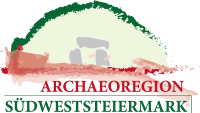
The ruins of Spangstein Castle, also known as “Ahnherrenschloss” (ancestral castle), are the ruins of a hilltop castle in the Stullnegggraben ditch, located about five kilometers northwest of Schwanberg. From the once mighty castle only a wall remnant is preserved, which is interpreted as a gate tower. The castle was situated on a rocky ridge at 570 m above sea level, which advances into the valley of the Stullneggbach creek from the west and is largely surrounded by rocky outcrops and steep slopes. Towards the west the castle was delimited by a ditch. The stone wall visible to the east of the moat, which is about 1.5 m thick, probably dates from the 13th century.

Spangstein belonged to a series of castles and fortified sites in the area around Schwanberg, which had to protect important mule tracks and crossings over the Koralm mountain range to Carinthia. The castle is the scene of a cruel legend in which the daughter of the lord of the castle is killed by her father because she refuses a marriage of convenience. The present ruin has been called “ancestral castle” since the middle of the 19th century. This is a corruption of the field name “Au” not far from the Stegweber inn. This land – meadows and pastures – was owned by the lords of Spangstein and their legal successors; the ruin should therefore be correctly called “Au-herrenschloss” (Au Lords’ castle).
After Emperor Heinrich III had taken a large part of today’s Schwanberg from his landlord Eppo in 1056 and handed it over to the Bishop of Brixen, in 1070 Waltfrid, a relative of Eppo, gave the area between the Sulm and the Stullnegg rivers also to the Bishop of Brixen. The bishop enfeoffed the noble family of Pettau with Schwanberg and Mainsdorf. The Pettauers left the area to the Spangsteiners, one of their servant families, who probably built a roadblock on a rocky spur in the Stullnegggraben in the middle of the 13th century, which was later expanded into a castle. The first documented member of this family is Erchengar de Spangesteyn, mentioned in 1255. The Spangsteiners experienced a rapid rise and were at times entrusted with the administration of the large Schwanberg dominion.
After the extinction of the Pettau family in 1438, the Schwanberg dominion and the Spangstein fortress, together with other estates, became the property of the Styrian sovereign. The Spangsteiners experienced a further significant increase in power and were appointed keepers of Schwanberg, but also administered other dominions, such as Eibiswald and Hohenmauthen. Sigismund von Spangstein even held the office of administrator in Graz from 1492 to 1497.
At the end of the 15th century Emperor Frederick III pledged the Schwanberg dominion to the Spangsteiners, who gave up their ancestral seat in the Stullnegggraben at this time at the latest; from 1555 onwards, the castle is only referred to as a ruin.
It is obvious, but not a proven fact that Spangstein Castle was affected by the Baumkircher feud, in the course of which Peuerlhof near Schwanberg was destroyed and probably Schwanberg Fortress was also damaged. It is certain that the Spangstein family had great financial problems around 1525, since the old Schwanberg fortress was in desolate condition and they could not rely on support from the emperor. Possibly it was no longer worthwhile to renovate the old Schwanberg fortress, which is why they abandoned it and rebuilt Schwanberg Castle.
After the Counter-Reformation, the Spangsteiners who had converted to Protestantism were forced to emigrate to the Protestant territory of the Empire; the Schwanberg and Spangstein estates fell to the Galler family, who were related to the Spangsteiners on their mother’s side. In 1685 the Trauttmansdorff family acquired the ruins of Spangstein, but in 1690 they sold it to the Saurau family, who had also bought the Schwanberg domain, thus uniting the two estates. In the middle of the 18th century the Spangstein ruin was sold to the rural estate known as “Müllersima.” In 2008, the ruins were subjected to an emergency renovation by the committee Altburg Schwanberg.
Text: Mag. Andreas Bernhard, Manfred Starkel

